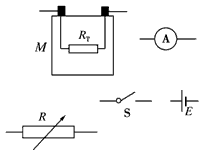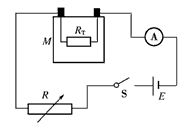问题
实验题
如图,一热敏电阻RT放在控温容器M内:A为毫安表,量程6 mA,内阻为数十欧姆;E为直流电源,电动势约为3V,内阻很小;R为电阻箱,最大阻值为999.9 Ω;S为开关。已知RT在95℃时的阻值为150 Ω,在20℃时的阻值约为550 Ω。现要求在降温过程中测量在95 ℃~20 ℃之间的多个温度下RT的阻值。

(1)在图中画出连线,完成实验原理电路图。
(2)完成下列实验步骤中的填空:
①依照实验原理电路图连线;
②调节控温容器M内的温度,使得RT的温度为95 ℃;
③将电阻箱调到适当的初值,以保证仪器安全;
④闭合开关,调节电阻箱,记录电流表示数I0,并记录____________;
⑤将RT的温度降为T1(20 ℃<T1<95 ℃),调节电阻箱,使得电流表的读数____________,记录_______________;
⑥温度为T1时热敏电阻的电阻值RT1=________________;
⑦逐步降低T1的数值,直至20℃为止;在每一温度下重复步骤⑤、⑥。
答案
(1)
(2)④电阻箱的读数R0;⑤仍为I0,电阻箱的读数R1;⑥R0-R1+150 Ω
